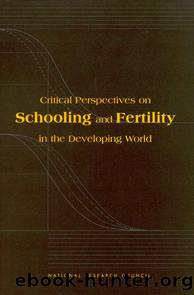Critical Perspectives on Schooling and Fertility in the Developing World by National Research Council

Author:National Research Council
Language: eng
Format: epub
Tags: Behavioral and Social Sciences : Population and Fertility Studies
Publisher: NATIONAL ACADEMY PRESS
Published: 1998-12-29T00:00:00+00:00
Fertility And Education In Historical Perspective
Given the central role played by population policy in the apartheid system of South Africa, it is remarkable how little solid evidence exists on the demography of the country. Even today, few of the data sources predating 1993 that contain information on fertility have been placed in the public domain. As a result, one must rely on reports that have not been subjected to the sort of scientific scrutiny they warrant (see Caldwell and Caldwell, 1993, for an excellent discussion). Fortunately, as the government has embraced the concept of openness and access to information, this situation has been remedied. Data collected by the Central Statistical Service and, in many cases, by units that are independent of the government are now routinely placed in the public domain; the Project for Statistics on Living Standards and Development (PSLSD) and the annual October Household Surveys are good examples.
The 1994 October Household Survey estimates South Africaâs population at about 40 million, of whom over three-quarters are black; half the rest are white, nearly 9 percent are mixed-race coloreds, and fewer than 3 percent are Asians, mostly of Indian descent. That survey estimates the total fertility rate (TFR) to be 4.1, although the Central Statistical Service views this as a substantial underestimate, particularly among blacks.
Much of the historical data on fertility and family planning in South Africa is described by van Zyl (1994), who also documents the methodologies used for the main surveys conducted by the Human Sciences Research Council that form the basis of these estimates. There are good reasons to be skeptical about the quality of some of those surveys, not least of which is the fact that population policy was an important political issue in South Africa, and it is far from clear that, at least at that time, the Human Sciences Research Council played a role that was entirely divorced from the political system. It is also prudent to treat comparisons across time with considerable caution since the surveys are not always comparable, and several focused on specific subpopulations. For example, in many surveys, the so-called homelands (where many of the poorest South Africans lived) were excluded from the samples, and in some surveys, fertility questions were asked only of married women. Setting aside the fact that the definition of marriage is complex in this society, many women who would not declare themselves as married have borne children, and teenage pregnancy rates are very high. According to the 1994 October Household Survey, about 33 of every 100 women have given birth out of wedlock. (See, for example, Preston-Whyte, 1990, for an insightful discussion.)
While remaining mindful of these caveats about data quality, it is useful to attempt to place South Africaâs fertility rate in historical context. TFR estimates for 1950 through 1990 for each of the four main racial groups in South Africa are presented in the upper panel of Figure 6-1.1 According to these estimates, in 1950, the TFRs of blacks, coloreds, and Indians were all
Download
This site does not store any files on its server. We only index and link to content provided by other sites. Please contact the content providers to delete copyright contents if any and email us, we'll remove relevant links or contents immediately.
Human Diseases (MindTap Course List) (by Team-IRA) by Marianne Neighbors Ruth Tannehill-Jones(844)
The Neglected Dimension of Global Security: A Framework to Counter Infectious Disease Crises by National Academy of Medicine Secretariat(421)
Statistical Methods in Health Disparity Research by J. Sunil Rao(399)
Imaging in Urology by Mitchell Tublin MD Joel B Nelson MD(394)
Short Course in Medical Terminology by Nath Judi L.;(331)
Cancer Cell Culture by Unknown(305)
Wilkins' Clinical Practice of the Dental Hygienist by Boyd Linda D.;Mallonee Lisa F.; & Lisa F. Mallonee(301)
Clinical Research in Occupational Therapy, Sixth Edition by Martin Rice;(300)
Murray's Basic Medical Microbiology E-Book by Murray Patrick R.;(282)
Anatomical Kinesiology by Gross Michael;(281)
Psychedelics As Psychiatric Medications by Nutt David;Castle David;(272)
Neuroscience Fundamentals for Rehabilitation by Lundy-Ekman Laurie(271)
Health Behavior: Theory, Research, and Practice by Karen Glanz & Barbara K. Rimer & K. Viswanath(270)
Rang & Dale's Pharmacology 9th Edition plus Flashcards 2nd Edition by Unknown(250)
Achieving Procreation : Childlessness and IVF in Turkey by Merve Demircioğlu Göknar(249)
Public Health and Society: Current Issues by Burke Lillian D.;Weill Barbara;(246)
The Handbook of Medicinal Chemistry by Simon E Ward;Andrew Davis;(245)
Primary Care Occupational Therapy by Unknown(239)
From Good Schools to Great Schools by Susan P. Gray & William A. Streshly(232)
